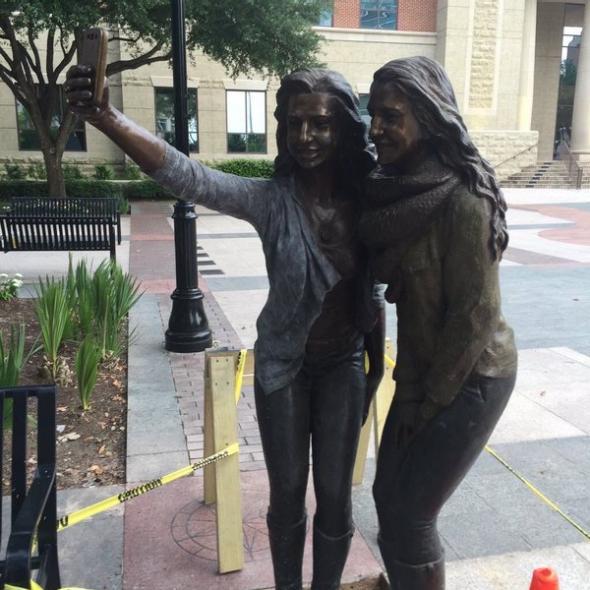Sugar Land, Texas, is having a rough week. According to the city’s official website, the Brazos River, which cuts through the region, is flooding, causing delays on local highways and displacing wildlife, including wild hogs and alligators. If you’ve heard about Sugar Land recently, though, it’s probably thanks to a more figurative flood: the torrent of tweets and Instagram posts about a controversial statue the city put up in the town square this May.
Cast in bronze, the statue in question depicts two young women posing for a selfie. As Mashable’s Brian Koerber reports, the online snark came fast and heavy, with one resident memorably quipping that she was “embarrassed for everyone” and others joking about the misappropriation of public funds. Sugar Land’s official Twitter account, for its own part, hastened to correct the latter concern, explaining that the “statues were a donation from a resident.” In BuzzFeed, Leticia Miranda cites an official explanation claiming that the sculpture—along with another of a man playing guitar—were meant to represent “activities that occur in the Square.”
Ultimately, it may be that putatively typical quality of the selfie sculpture that makes it so ripe for mockery. Under ordinary circumstances, artworks function by estranging us from the everyday, presenting even the most familiar objects and ideas in ways that invite us to rethink our relationship to them. By presenting a conventional scene in an unusually realistic style—note the well-draped but unfashionable cardigan that one of the women wears—the Sugar Land sculpture undermines that experience.
The strangeness of the selfie statue may also be a matter of its formal incongruity. Bronze statuary evokes effort—this is the material of classical antiquity, a material suited for epic heroes and the artists who portray them—while taking a selfie is (at least in theory) the most effortless of activities. With the advent of forward-facing cameras on smartphones, it’s almost too easy to take a picture of oneself. Strange as it now seems, however, banality and bronze have long been twins. Discussing statuary in the ancient world, the art critic Philip Kennicott explains, “Although marble was the preferred medium for representing the ideal, especially the gods, bronze became the preferred medium for making images of ordinary humans.”
Here, though, what the sculpture depicts is presumably as important as the way that it depicts it. Notably, the sculpture’s guitar-playing counterpart has received far less critical attention, despite its similar triviality. That may be because we’re more comfortable thinking about what the guitarist does as an artistic practice, making it easier to comprehend the sculpture itself in artistic terms. Irritating as buskers often are, we can at least acknowledge that what they do exists in a meaningful continuity with more elevated forms of music.
By contrast, we often have a harder time locating selfies with the broader horizon of visual art. As I’ve argued before, there’s a degree of inherent sexism in that disconnect, since selfies have become a powerful tool for women seeking to control their own images, a desire that men have typically greeted with contempt. This seems to be what Refinery 29’s Michael Hafford has in mind when he writes, “The general tone of people criticizing [the statue] is meaningless ludditism at best and outright misogyny at worst.”
If anything, though, the Sugar Land selfie sculpture is about the ways we all make and consume art in the digital age. Discussing the sculpture in the Daily Beast, Lizzie Crocker writes, “Those bemoaning art that glorifies our narcissistic, social media-obsessed culture should consider that, historically, most ‘meaningful’ statues of people … were monuments to the self.” In the past, however, to memorialize oneself in statuary form, one had to be powerful, a power retroactively confirmed and stabilized by the resulting image. In the absence of such easy associations, it’s more difficult to confer value on an artwork. That, in its own turn, makes it all too easy to laugh off objects like the selfie sculpture.
Digital photography and social media platforms don’t just democratize self-representation; they also disrupt the illusion of permanence that once went along with portraiture. No longer the exclusive domain of the powerful, digital art increasingly captures the flux of experience itself. Even when they supplement our fragile memories, selfies have an ephemeral quality: Forever taking pictures of ourselves, we are also forever letting old images dissolve as new ones take their place.
It’s this situation that the Sugar Land statue—with its ordinary women doing a very ordinary thing—captures, showing us ourselves as we are in the moment, but paradoxically doing so in a way that lingers. Indeed, there may be a kind of associative embarrassment to looking at it, something like that of the #caughtgramming hashtag, which collects photographs of Instagram users who are themselves taking photos. But where the hashtag mocks, the statue is all the more richly disquieting for its willingness to celebrate its two subjects in their normalcy. Instead of dismissing it, we should dwell on its strangely arresting familiarity.
